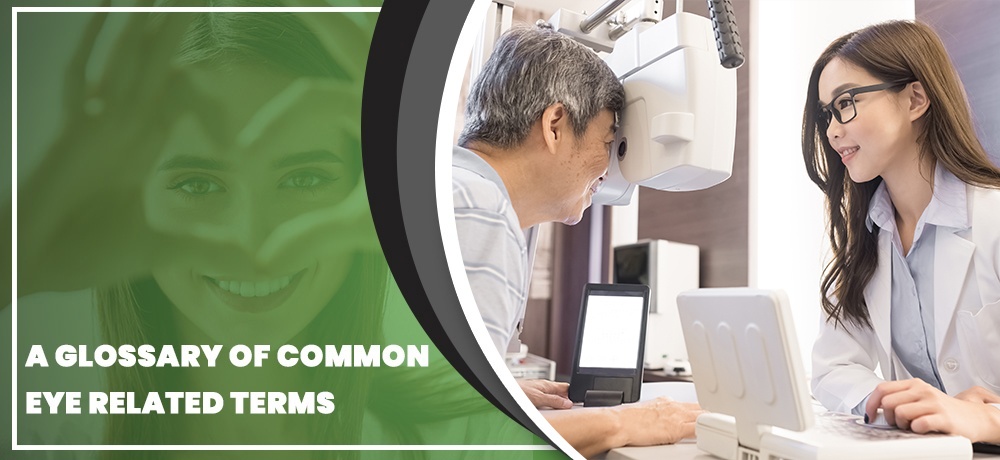A Glossary Of Common Eye Related Terms

Every industry has its own language and terms. These words and phrases can be confusing to anyone who is not part of the daily operations of a specific industry, and the world of eye care is no exception.
To help you understand the terms, acronyms, and phrases regularly used when you visit your eye doctor or optician, Chan Optometry has created this handy reference guide. Here you’ll find valuable information allowing you to comprehend and communicate your needs effectively.
Nearsightedness or Myopia
It is caused by the elongation of the eye. This condition results in light being focused in front of the retina. Myopia causes your vision to be out of focus when looking at things far away, but still clear up close.
Farsightedness or Hyperopia
This is the opposite of nearsightedness. It is a shortening of the eye, causing light to be focused behind the retina. Farsighted people typically can focus through the prescription. However, it can cause eye strain, tiredness, and even blurry vision. It can affect your distance vision and your near vision but may affect your near vision more.
Astigmatism
It is a refractive error caused by an irregularly shaped eye. This can cause glare or shadowing of images. This is easily correctable through glasses, contact lenses, or refractive surgery.
Presbyopia
This is an age-related deterioration of the natural lens inside the eye, leading to a more rigid lens. The onset of this issue is usually around forty years of age and leads to a blurred near vision. You can correct this with reading or progressive glasses, but multifocal contact lenses and surgery are becoming more popular options.
Cataracts
This refers to the clouding of the natural lens inside the eye. It is mostly age-related as it typically occurs for individuals from sixty to eighty years of age. Besides age, cataracts can also be caused by certain medications, trauma, or can even arise at birth. Treatment for cataracts at this time involves cataract surgery, although there are promising clinical trials of a medicated eyedrop that can reverse the degenerative effects of cataracts.
Retina
This is the tissue in the back part of the eye that detects light. It is similar to the “film” on a vintage camera. It processes light from the outside world and sends that information to the brain (or computer chip inside the camera). It is one of the most important structures inside the eye.
Cornea
This is the clear tissue that acts as a protective barrier over the eye. It is the structure that most contact lenses sit upon. The cornea is one of the most innervated parts of the body, yet it is the only part that does not have any blood vessels.
Bifocal glasses
Bi (means two) focal (focus points) glasses allow for two different prescriptions on one lens. This allows the wearer to see at two different distances (i.e., far and near). Previously, bifocal lenses would have a window on the lens for near prescriptions. But, these days, most bifocal lenses are also known as progressive lenses. Progressive lenses do not have any lines or windows, as the prescription “progresses” from distance to near as you move down the lens.
Optician
An optician is a licensed, regulated salesperson who dispenses eyeglasses or contact lenses. They have to complete a two to four-year college degree to practice this profession.
Optometrist
Optometrists are the family doctors for eyes and the visual system. They must complete a university undergraduate degree, and then complete four years of optometry school. They are licensed, regulated doctors that can prescribe glasses or contact lenses as well as treat and manage ocular diseases and conditions.
Ophthalmologist
Ophthalmologists are the eye specialists going through undergraduate, medical school, residency before further specializing in ophthalmology. Ophthalmologists can perform ocular surgery, laser treatment, and injections.
If you’re looking for more information on eye care and treatments, reach out to the experts at Chan Optometry. We offer specialized care and assistance through an experienced eye doctor and optometrist in Markham, Ontario. Our team is dedicated to helping you protect and improve your visions. We excl in eye exams, contact lenses, orthokeratology, myopic control, laser vision co-management, retinal photography, and other optometry services. We even help you identify potential health issues beforehand so you can take control and prevent them.
To learn more about how we can help you, view our full list of services here or get in touch with us here.